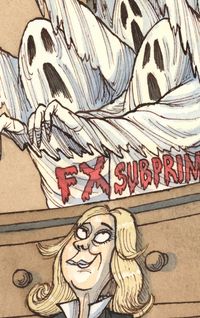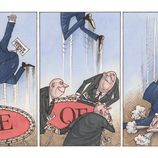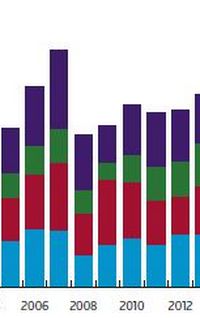Only a small number of European banks have the firepower and geographic reach to compete with rampant US rivals. The rest must either focus on pockets of excellence or merge.

The sale in June 2018 by the UK government of a 7.7% stake in Royal Bank of Scotland served as a stark reminder about how the fortunes of US and European banks have diverged since the financial crisis.
The deal was highly symbolic for Europe’s capital markets bankers, not just because it resulted in a £2bn paper loss for the UK taxpayer a decade after RBS was bailed out, but because the investment banks selected by the UK government to handle the sale were all American.
The RBS deal was just another opportunity for US banks to notch up another win on European soil, where they have already made record gains since the crisis.
Globally, they have established a dominant market share in every investment banking product, according to analysis outfit Coalition: during the first half of 2018, US banks secured 62% of global investment banking revenues, while European rivals grabbed only 38%.
There’s no doubt that US banks enjoy a number of structural advantages in investment banking. For a start, the US capital markets are the deepest and most liquid in the world, and account for half of global corporate finance fees, which are also higher than in Europe.
US banks also took their medicine early, with the US Treasury forcing them to recapitalise in 2008 with the enforced Troubled Asset Relief Programme. The US authorities also encouraged consolidation as a response to the crisis, with Bank of America taking over Merrill Lynch, and JP Morgan buying Bear Stearns.
“In the initial aftermath of the financial crisis US banks had a scale and capital advantage and were further helped by a domestic economy that has consistently grown over the last decade,” said Stephen Dainton, global head of equities at Barclays.
And in the last 10 years, the S&P has risen by 300% while the Eurostoxx has climbed by a relatively sluggish 75%. “These structural advantages have enabled US banks to follow strategies that have been consistent,” said Dainton.
During the same period, US M&A activity has reached new highs, and between 2016 and 2017 US debt capital markets posted three successive years of record volumes, factors that played to the strengths of big US universal banks with a home market advantage – and that allowed them to print money that can be put to use elsewhere.
Now they are also becoming dominant in Europe, where many home-grown investment banks have taken a radically different approach. While US banks have pressed home their advantage, Europe’s banks have pulled in their horns, cutting huge swathes of their trading operations, exiting countries and product lines.
In many ways, they only have themselves to blame. European banks were slow to adapt and as a result some are still trying to figure out their post-crisis future or have dialled down their commitment to investment banking.
Ongoing restructuring means that European banks have suffered from strategic introspection, which has compounded their competitive disadvantage.
As an indication of the level of upheaval, Deutsche Bank in April appointed Christian Sewing as its third CEO in six years. His predecessor John Cryan, who was ousted after struggling to turn the lender around, summed up the bank’s problems in January with his customary bluntness.
“We began restructuring about five years later than the banks in the US,” he said. ”Unfortunately, we did not capitalise on our advantages after the financial crisis and adjusted our business model far too late.”
DITHERING
Deutsche’s dithering cost it its position as Europe’s top corporate finance house in terms of fees and, according to Refinitiv data, it now languishes in eighth position for the first three quarters of 2018, behind Credit Suisse and Barclays. All of the top five spots are occupied by US banks.
While US banks have enjoyed a structural advantage, Europe’s investment banks have faced economic and regulatory headwinds. The region’s economy has stuttered while regulations have been tougher than in the US, with local supervisors introducing strict targets on leverage ratios and compensation, while in the UK the introduction of the “senior managers regime” has made individuals more accountable – and the industry less attractive.
“From a scale point of view the European banks have a challenge but from a return on resources perspective we are right up there. Not being the biggest doesn’t preclude us from being the best in terms of profitability or providing great value for our shareholders,” said Jason Barron, interim global head of equities at UBS.
Faced with a rampant US banking industry, Europe’s banks have re-tooled as returns-driven firms focusing on areas that consume less capital.
A patchwork competitive environment has emerged, where banks have developed pockets of excellence, either by region or product, where they can compete on level terms. UBS has cut back its FICC business, for example, but remains a top four player in global equities. Local rival Credit Suisse is coming to the end of a revamp that has seen it moving capital from its markets division into Asian wealth management.
Only a select number of European firms have the firepower and ambition to compete as fully-integrated corporate and investment banks. BNP Paribas is accelerating an expansion of its European corporate and investment banking activities, including a big push in the UK, in order to bridge the gap with US rivals.
Meanwhile, Barclays has come out fighting. Speaking during the bank’s third-quarter results call, CEO Jes Staley told analysts: “There has been a comment that European investment banks can’t compete with the US, and I would just point out that four quarters in a row we have gained market share.
”The reality of what is happening with our markets franchise really belies the proposition that we can’t compete.”
Barclays differs from most of its European rivals in that it has a significant foothold in the US thanks to its 2008 purchase of the North American business of Lehman Brothers. For other European firms that lack a US presence, a choice is emerging – either diversify their business away from investment banking to seek more stable returns, or gain scale through consolidation.
MIND-SET SHIFT
Earlier this year, a report by Morgan Stanley and Oliver Wyman raised the prospect of big-ticket M&A as a shot at redemption for Europe’s banks.
“We see scale players, broad-based corporate franchises and specialist players being well placed,” the report said. “We believe this raises profound questions for EU policymakers over the future shape of the wholesale sector in Europe.”
But for mergers to take place would require a fundamental shift in mindset among European regulators, bank management and shareholders. Since the crisis revealed banks to be “too big to fail”, the prevailing regulatory backdrop has gravitated against big bank mergers.
Plus, bankers say management’s number one priority is still preservation of capital and no CEO would take the risk that a deal would destroy value. There is also a lack of confidence about whether banks have sufficiently cleaned up their balance sheets.
Nonetheless, in 2018 the prospect of big bank mergers resurfaced with reports that Germany’s Commerzbank could be a target, either from Deutsche or BNP Paribas.
At the same time, there was talk that UniCredit of Italy might be considering a tie-up with France’s Societe Generale. Both deals have logic, but bankers say they are some way off. “Both Deutsche and UniCredit have organic turnaround plans that they have to finish first,” said one FIG banker.
There is a growing sense that European policymakers should start to support consolidation, while one senior banker argues that the regulatory climate could be changing. “Most European banks already have CET1 ratios about the G-SIB buffer limits, so merging wouldn’t make that much difference to their cost of capital,” said one senior banker.
Consolidation has certainly begun in selective areas such as equities, where the revised Markets in Financial Instruments Directive (aka MiFID II) is forcing smaller brokers to merge as bigger banks grab a larger share of equities sales, trading and research business from institutional clients. AllianceBernstein is currently in talks to acquire specialist UK research firm Autonomous and that is a trend that many expect to continue in 2019.
FIGHTBACK BEGINS
Some believe an opportunity may be emerging for a European fightback. The prospect of a slowdown in the US could provide the spark, while some US banks may review their exposure outside their home market.
“European companies don’t just want a group of US banks as their only potential counterparties. There is an opportunity for a leading global European investment bank to thrive.” said Barclays’ Dainton.
“European banks can recover but they need a more positive economic cycle in Europe, where interest rates need to be higher,” said Samir Assaf, CEO of HSBC’s global banking and markets division.
”In the short term – in the next three to five years – I think it is difficult to catch up; but it depends what they are trying to catch up with. Is it size, return on equity, or market share? If you know where to compete then it can work.”
To see the digital version of IFR Awards 2018, please click here.
To purchase printed copies or a PDF of IFR Awards 2018, please email gloria.balbastro@refinitiv.com.




















